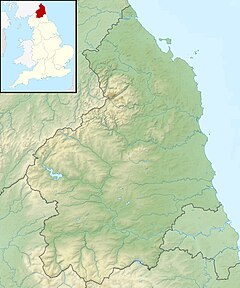River Derwent, North East England
This article needs additional citations for verification. (December 2013) |
| River Derwent | |
|---|---|
 Derwent near Allensford | |
| Location | |
| Country | United Kingdom |
| County | |
| Physical characteristics | |
| Mouth | |
• location | River Tyne |
• coordinates | 54°57′49″N 1°40′46″W / 54.9635°N 1.6794°W |
The River Derwent is a river which flows between the historic county boundaries of Durham and Northumberland in the north east of England. It broadens into the Derwent Reservoir, west of Consett. The Derwent is a tributary of the River Tyne, which it joins at Derwenthaugh near Gateshead.
The river flows for 35 miles from its origin, where two streams, Beldon Burn and Nookton Burn meet approximately a mile west of Blanchland, to Derwenthaugh where it flows into the River Tyne (the confluence is between Blaydon and the MetroCentre complex). On its journey, the River Derwent flows through places such as Allensford, Shotley Bridge, Blackhall Mill and Rowlands Gill. The Derwent Walk Country Park at Rowlands Gill[1] is named after the river.
The name Derwent comes from the Brythonic/Early Welsh word for oak derw and valley -went.[2]
The Muggleswick-born writer, John Carr, wrote a 40 verse poem "Ode to the River Derwent".[3]
References
[edit]- ^ "Derwent Walk Country Park and Derwenthaugh Park". Gateshead Council.
- ^ alternatively water dour / der/ dar and white (g)-went. See under DUR http://freepages.genealogy.rootsweb.ancestry.com/~pbtyc/Misc/Etymology.html
- ^ The Bishoprick Garland; Or, A Collection of Legends, Songs, Ballads, &c. Belonging to the County of Durham (europeanlibraries ed.). Nichols, and Baldwin & Cradock. 1843. pp. 43–48.
External links
[edit] Media related to River Derwent, North East England at Wikimedia Commons
Media related to River Derwent, North East England at Wikimedia Commons- Derwent Photographs
- Bridges On The Derwent

